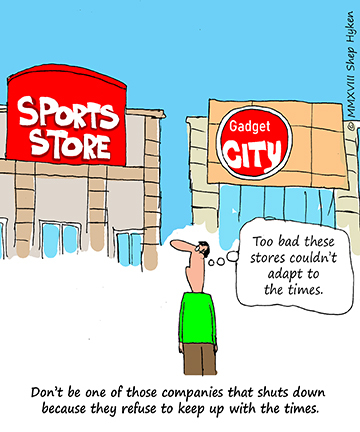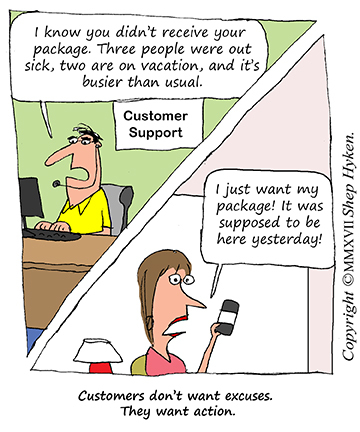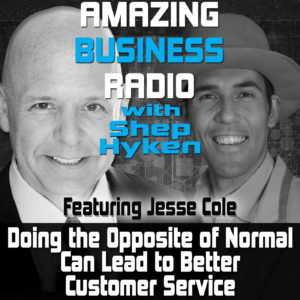Shep Hyken's Blog, page 155
January 9, 2018
Amazing Business Radio: Jesse Cole
Doing the Opposite of Normal Can Lead to Better Customer Service
Shep Hyken Interviews Jesse Cole, Author of Find Your Yellow Tux
Do your “fans” come first? When customers come first, success follows.
<span data-mce-type=”bookmark” style=”display: inline-block; width: 0px; overflow: hidden; line-height: 0;” class=”mce_SELRES_start”></span>
Shep Hyken speaks with Jesse Cole about how to stand out from the competition and create perfect customer service experiences for your customers.
Top Takeaways:
To stand out in business, do the opposite of what is normal. Do what the competition is not doing.
Three areas where you need to find your “Yellow Tux”
Yellow Tux yourself – Have a mirror moment. Figure out what frustrates you about your life and how you can start over. Then, figure out what you are best at and run with it.
Yellow Tux your business – Have the same mirror moment. Focus on the areas you are best at, and don’t force yourself to do the things you aren’t skilled in.
Yellow Tux your legacy – Think about the difference you make, and not just on your accomplishments. Significance over success is what you should be after.
Six steps to creating attention, standing out, and creating the perfect customer service experience:
Have a mirror moment – Look at where you are and where you would like to be.
Ask the best question – What can you and your company be the best at?
Embrace the different mindset – Whatever is normal, do the opposite.
Hello world moment – Create attention to stand out.
Love your customers more than you love your product.
Make reinvention part of your DNA – Change constantly in order to create attention.
About:
Jesse Cole is the owner of Fans First Entertainment, who owns and operates the Savannah Bananas and the Gastonia Grizzlies. Cole is the author of Find Your Yellow Tux – How to Be Successful by Standing Out. He is also the host of the Business Done Differently podcast.
Shep Hyken is a customer service and experience expert, “New York Times” best-selling author, award-winning keynote speaker, and your host of Amazing Business Radio.
“You will make your business go so much further if you go all in on your strengths. Everyone talks about being well-rounded, but they’re actually doing everything half as well as they should be.” – Jesse Cole
This episode of Amazing Business Radio with Shep Hyken answers the following questions … and more:
How can I stand out from my competition?
How can I put my customers first?
How do I gain a competitive edge?
The post Amazing Business Radio: Jesse Cole appeared first on Shep Hyken.
January 5, 2018
Guest Blog: Instant Customer Service – Just Add Text Message
This week we feature an article by Ford Blakely about text messaging which can provide that instant, convenient and low-friction customer experience that delivers delight. I like the idea of the convenience of texting but as Ford points out, you must have a strategy in place for your team to answer texts correctly. – Shep Hyken
 Let’s face it, customer service is the lifeline of any company. Of course, getting new customers is just as important, but it’s useless if your customer service experience is suboptimal.
Let’s face it, customer service is the lifeline of any company. Of course, getting new customers is just as important, but it’s useless if your customer service experience is suboptimal.
According to Forbes, Businesses are losing $62 billion per year through poor customer service.
Bad customer service doesn’t just impact your revenue now, but can dramatically affect it in the future as study shows 86% of consumers said they’ve stopped doing business with a company after a bad customer experience.
This bad experience will also snowball into losing potential new customers due to 60% of consumers say that they will post a negative review online if they experience poor customer service. That’s 3 times more than positive reviews. When customers are angry, they tell the world about it.
Reasons for bad customer service
There are many reasons businesses have poor customer service, and they can vary by industry, but in my opinion, there are four common themes that cause bad customer service.
Not enough training: Good customer service starts with the employees. If your staff is not knowledgeable about the product or are not properly trained on how to speak to it the right way, it creates customer frustration and you lose credibility as a provider of the product. Another aspect of training is understanding human emotions. Customer service agents often have to deal with already angry customers and different types of issues, so having knowledge about how to properly respond to those scenarios is extremely important to customer service and your brand as a whole.
Not knowing your customers: There’s nothing more frustrating than having to repeat the same answer over and over again. Study shows that 89% of customers get frustrated because they need to repeat their issues to multiple representatives. Customer service agents need to have customer data available at their fingertips, and this includes support history and other customer preferences you may have in your database. Also, listen to your customers when they tell you their problems instead of going to a templated answer. If you are going to give the same answer to every customer, you might as well replace it with robots. Remember that personal is memorable.
Too slow: There are few things more annoying than having to wait on hold when you need your question answered right away. Whether it’s holding on the phone or waiting to get an email response back, they often take longer than we want. Research from Harris Interactive found that 75% of consumers believe that it takes too long to reach a live customer service agent. This means that there are potential process or technical issues within the customer service department that can’t support customers in a timely manner. No matter what the issue is, it is important to have customer support in as many channels as possible.
No multi-channel support: This goes back to knowing your customers and what they like. Not all customers like to communicate the same way, especially when there are multiple ways to engage. Customer service channels like phone, email, live chat and even social media have been popular ways businesses are multiple channels to support customer needs. There’s one that is missing. Text Messaging.
How text messaging creates instant customer service
Text messaging is starting to become a popular channel for businesses to support customers as texting as consumer trends show that 81% of Americans text regularly and over 6 billion text messages are sent every day.
This trend seems to cross over to consumer-to-business communication as 89% of consumers want to use messaging to communicate with businesses. (Source)
This is not a surprise to me because as a consumer myself, I really don’t like talking on the phone unless it’s absolutely necessary. The speed and convenience of text messaging in our daily lives can and should be translated into a business environment.
Enabling text messaging as a customer communication channel helps solve some of the issues that cause poor customers service.
Texting provides faster service: Texting by nature is fast and convenient. When businesses interact with customers by text message, it reduces calls being on hold as customer service agents can have two-way conversations multiple customers simultaneously in real time, reducing the backup of customers waiting to get a hold of you.
Texting is personal: Texting provides another level of personalized service that supports the overall customer experience. Businesses that use texting for customer support usually leverages a secure business-level text messaging software that is able to store customer profile information as well as past conversation history. When properly used, customer service agents can quickly pull up customer data and pick up where the conversation left off previously which helps to provide a more personalized and speedier service.
Texting is low friction: If you make it hard for customers to contact you, they will become frustrated and possibly leave you for your competitor. According to Harvard Business Review, the number 1 factor in customer loyalty is reduction of customer effort. The versatility of text messaging allows anyone to send and receive messages practically anywhere, anytime. It removes the need for internet access or email logins. It’s really instant customer service. For businesses, a study from McKinsey customer experience survey showed that when companies provide a low effort experience throughout the entire customer journey saw 10-15% increases in revenue and a 20% in customer satisfaction.
The takeaway
Although the idea of text messaging is great, make sure that you have a strategy in place, so your staff knows how to interact with customers via text messaging.
Also, be sure to set goals and measure performance to create accountability and have knowledge of how it’s doing compared to other customer service channels.
Practically all consumer experiences today are instant or on-demand. Why not customer service? As I outlined in this article, text messaging provides that instant, convenient and low-friction customer experience that delivers delight, which often translates into more revenue, happier customers, and most importantly lifelong loyal customers.
Ford Blakely is the founder and CEO of Zingle. As a frustrated consumer with an entrepreneurial spirit, Ford sought to figure out a quicker way to order his latte in the morning. He did – and in 2009 Zingle was born as the first two-way, business-and-customer communication platform.
For more articles from Shep Hyken and his guest contributors go to customerserviceblog.com.
Read Shep’s latest Forbes Article: Ten Customer Service And CX Predictions For 2018
The post Guest Blog: Instant Customer Service – Just Add Text Message appeared first on Shep Hyken.
January 3, 2018
Five Customer Service Must-Do’s For 2018
 Over the last few weeks, I’ve been reading about predictions and trends for 2018. It got me thinking about the actions we must take to be competitive. Regardless of your industry, everything has changed about the way we do business. There are some businesses that claim they’ve done things the same way for years, decades, even a century. They claim they do business just as their fathers and grandfathers did. Nothing has changed. I disagree.
Over the last few weeks, I’ve been reading about predictions and trends for 2018. It got me thinking about the actions we must take to be competitive. Regardless of your industry, everything has changed about the way we do business. There are some businesses that claim they’ve done things the same way for years, decades, even a century. They claim they do business just as their fathers and grandfathers did. Nothing has changed. I disagree.
Take a taxidermist, for example. Things have been the same in this business for over 100 years, stuffing and mounting animals. The owner claims nothing has changed… Except for today, he has a website, a Facebook page, and a mobile phone. None of these were around when his great-grandfather started the business. Much has changed.
A business must keep up with the times. If they don’t, they will be disrupted and find themselves either playing catch up or worse, shutting down altogether. With that in mind, I’d like to share five customer service tips every business must do to stay competitive in 2018:
Embrace the changing expectations of your customer: This one I’ve touted every year. The customer expects more than ever. They no longer compare you to just your competitors. They compare you to any company they like doing business with. So, be prepared to keep up.
Personalize the experience: The concept of personalization has been around for a long time. Make recommendations that are specific to each customer. Whether you invest in sophisticated software that tracks and analyzes customer data, or you simply remember them when they walk through your doors, recognize your customers want and expect you to give them a personalized experience.
React quickly, especially on social media: When a customer needs support or a question answered and they email it to you, they don’t want to wait two days to get a response. They don’t want to call and be put on hold for an hour. They want a resolution now. If you don’t already offer good self-service solutions that will get customers their answers immediately, at least be able to respond to them in a reasonable amount of time, not hours or days.
Don’t let technology pass you by: Invest in the right technology to drive a better customer experience. High cost is no longer an excuse. Many software solutions have come so far down in cost that even the smallest businesses can afford them. Stay up-to-date with the solutions available to you that can help drive a better customer experience.
Be more convenient than you’ve ever been before: If you want to separate yourself from your competition, be more convenient. How easy are you to do business with? It could be extended business hours, more locations, or an easy-to-use website. The company that makes it easier and more convenient for the customer wins.
There you have it, five ways to deliver a better-than-ever customer service experience. Are there more ways? Sure, there are! I’ve written books on many, many more ideas, tactics, and strategies. But, these are what I’d call “keep-up-with-the-times” types of tips. So, go out there and take care of the customer like you never have before. That’s what it will take to make 2018 great for your business.
Shep Hyken is a customer service expert, keynote speaker, and New York Times bestselling business author. For information, contact 314-692-2200 or www.hyken.com. For information on The Customer Focus customer service training programs, go to www.thecustomerfocus.com. Follow on Twitter: @Hyken
customer service training programs, go to www.thecustomerfocus.com. Follow on Twitter: @Hyken
(Copyright © MMXVIII, Shep Hyken)
The post Five Customer Service Must-Do’s For 2018 appeared first on Shep Hyken.
January 2, 2018
Amazing Business Radio: David Horsager

The Most Important Business Strategy: Create Trust
Shep Hyken Interviews David Horsager, Author of The Trust Edge
Do your customers trust you?
<span data-mce-type=”bookmark” style=”display: inline-block; width: 0px; overflow: hidden; line-height: 0;” class=”mce_SELRES_start”></span>
Shep Hyken sits down with David Horsager, discussing the importance of trust and how gaining it from your customers is the most significant thing you can do.
Top Takeaways:
Trust is a confident belief in a product or an organization. When there is confident belief, everything changes. When trust goes up, creativity and loyalty do as well. Cost and suspicion goes down.
When employees get treated properly, it trickles down and the customers feel that.
8 pillars that hold up the trust edge: Without just one, you could lose trust. All 8 are necessary to gain trust.
Consistency – If you do something consistently, customers will come to expect you to do that, whether it be good or bad.
Clarity – People trust the clear, and mistrust the ambiguous.
Compassion – If customers believe they are cared about, they will trust you.
Character – Do what is right, not what is easy.
Competency – Stay fresh and relevant, and capable of being trusted.
Commitment – Companies that are trusted most are ones that stick with it.
Connection – How we connect and collaborate is vital.
Contribution – Trust comes to those who get results, those who perform.
About:
David Horsager, MA, CSP, CPAE, is the CEO of Trust Edge Leadership Institute, national bestselling author of The Trust Edge, inventor of the Enterprise Trust Index, and director of one of the nation’s foremost trust studies: The Trust Outlook.
Shep Hyken is a customer service and experience expert, “New York Times” best-selling author, award-winning keynote speaker, and your host of Amazing Business Radio.
“A lack of trust is the biggest expense for organizations and individuals.” – David Horsager
This episode of Amazing Business Radio with Shep Hyken answers the following questions … and more:
How can I build more trust with my customers?
How can I build more trust with my employees?
How can I show my employees that I appreciate them?
How can I rebuild trust with my customers?
What is essential for creating better experiences?
The post Amazing Business Radio: David Horsager appeared first on Shep Hyken.
January 1, 2018
5 Top Customer Service Articles For the Week of January 1, 2018
Each week I read a number of customer service and experience articles from various resources. Here are my top five picks from last week. I have added my comment about each article and would like to hear what you think too.
15 Customer Experience Trends for 2018 by Bruce Temkin
(Customer Experience Matters) Every year, Temkin Group publishes a list of customer experience trends for the upcoming year. We identify some of the key things that CX professionals will need to be on the lookout for throughout the upcoming year. Well, it’s that time again.
My Comment: Let’s start the New Year with a list of 14 customer experience (CX) trends for 2018 by my friend Bruce Temkin. Bruce is one of the gurus in this area and when he talks – or writes – we should pay attention. If CX is important to you, and I know it is, then pay attention to what Bruce predicts for 2018.
Weird job titles like ‘rockstar’ ‘guru’ and ‘ninja’ are on the rise by Jeanette Settembre
(Moneyish) Companies are advertising for tech, sales and customer service jobs with quirky sounding job titles.
My Comment: This article falls on the topic of your company’s culture. It focuses on some of the fun and creative titles that companies now assign their employees. Job titles like rock-star, ninja and guru are finding their ways into the corporate world. We do it at our company. We have a “Manager of Many Things.” And, my title… Chief Amazement Officer.
AI is what dreams are made of. Just ask Disney. by Page Grossman
(Relate) We talk a lot about artificial intelligence and the impact AI will have on our culture and workforce, and invariably the emotions run high. From frustration to fear to anger—from job loss to cold customer service to disappearing storefronts and careers.
My Comment: Disney may be the self-proclaimed “Happiest Place on Earth.” Who am I to disagree?! I love Disney. And, I love how they are upping their game in the CX world by incorporating AI. The article is short but will give you some insight into a company whose success depends on creating one of the ultimate customer experiences.
Looking into the Customer Support Crystal Ball: 6 Predictions for 2018 by Anand Janefalkar
(CustomerThink) As we look towards 2018, forward-thinking organizations need to embrace emerging customer support trends in order to position themselves for success. Let’s take a look at what lies ahead in the coming year.
My Comment: Here’s another article focused on some predictions for 2018, this time in the customer support world. I especially like number five which touts that customer support will no longer be viewed as a cost center, but a driver of revenue. This concept has been around for a while. Customer support is actually marketing, disguised as customer support. And, marketing drives revenue. What’s happening today is more and more companies are believing it.
Everything you wanted to know about holiday returns by Debbie Carlson
(Chicago Tribune) Was the holiday gift you received the wrong size, or just not what you hoped for? The good news is you have extra time to return that ill-fitting sweater or those duplicate games. The bad news? The specifics of many retailers’ return policies don’t usually change just because it’s the holidays.
My Comment: To wrap up this week’s roundup of my favorite customer service articles, here’s one that ties into the holidays. It’s only been a week since Christmas. I’m sure you’ve received a gift that you “just don’t know what to do with.” (In other words, you want to return it.) This article will help you make that holiday return a little easier. And, one piece of advice that’s not in the article. If you can’t return the item, re-gift it. Or, even better, give it to someone who is less fortunate than you. There are plenty of organizations that would love you to donate the gifts you don’t plan to use.
Shep Hyken is a customer service expert, professional speaker and New York Times bestselling business author. For information contact or
www.hyken.com
. For information on The Customer Focus customer service training programs go to
www.thecustomerfocus.com
. Follow on Twitter: @Hyken
customer service training programs go to
www.thecustomerfocus.com
. Follow on Twitter: @Hyken
The post 5 Top Customer Service Articles For the Week of January 1, 2018 appeared first on Shep Hyken.
December 29, 2017
Guest Blog: Customer Service in Retail – Infographic
This week we feature an article by Patrick Thuot who shares an infographic about how customer service can help the retail industry. A customer-centric approach can help any type of business succeed. – Shep Hyken
With the proliferation of the Internet and the ubiquity of smartphones, tablets, and laptops, the whole retail industry has experienced huge disruption. It has meant that brick-and-mortar stores are now competing with online retailers where location is not an issue. This translates to offline retailers having to fight back to create an offering that will entice their customers to come in. Encouraging the public to come in-store isn’t easy in today’s world when a consumer can easily log onto a website and order just about anything they want as they commute, as they work, or even as they lie in bed.
To entice those customers to come in-store requires there to be something worth coming in for. So, in today’s world, we hear a lot about “experiential marketing” in terms of retail. More and more offline retailers are focusing on creating an experience in-store that will encourage customers to not only come in but also to return again and again. Things like in-store fashion advisors or coffee stations are examples of this, but retailers are constantly trying to think of new ways to get customers to walk through the doors. While these examples and suggestions might appear a little fleeting, one thing that will definitely encourage customers to return repeatedly is excellent customer service.
This is the major advantage that brick-and-mortar stores have over their online counterparts, in that the customer will come face-to-face with someone who can assist. This offers an opportunity to delight the customer. Of course, excellent customer service doesn’t just happen; it requires training and it requires the position and viewpoint of customer service policy to be well-defined.
Staff will require ongoing training, and there should be regular customer service reviews to ensure that it is all working well across the store(s). If mistakes are made, and there will always be customer service missteps along the way, it’s vital that the management and staff learn from the mistakes. Roleplaying is a great way to train staff, but management might even consider a third party to come in to cover some training at the onset. This infographic from the guys at Storetraffic aims to bring focus to retailers in relation to customer service in their brick-and-mortar businesses. It highlights some important statistics that indicate how important excellent customer service is, details how to strategize a customer service policy within your organization, and it focuses on some expert advice on the area. Check out the graphic for more.

Patrick Thuot is Vice President of Storetraffic. Storetraffic provides software and hardware to businesses who wish to use people traffic counting data to improve their service levels and more.
For more articles from Shep Hyken and his guest contributors go to customerserviceblog.com.
Read Shep’s latest Forbes Article: Macy’s Big Magic Trick: How The World’s Largest Store Keeps Its Customers Coming Back
The post Guest Blog: Customer Service in Retail – Infographic appeared first on Shep Hyken.
December 27, 2017
Complaining Customers Aren’t Looking for Excuses
 The other night, I was out with some friends. We were at a well-known place, listening to music and relaxing. One of my friends said she wanted something chocolate, so she ordered a piece of chocolate cake. A few minutes later it arrived, and she took her first bite. You could tell by looking at her facial expression that she was not happy. She said it tasted very dry. Not what she expected. So, I tried a bite. She wasn’t kidding. It was worse than dry. It tasted like chocolate flavored sawdust.
The other night, I was out with some friends. We were at a well-known place, listening to music and relaxing. One of my friends said she wanted something chocolate, so she ordered a piece of chocolate cake. A few minutes later it arrived, and she took her first bite. You could tell by looking at her facial expression that she was not happy. She said it tasted very dry. Not what she expected. So, I tried a bite. She wasn’t kidding. It was worse than dry. It tasted like chocolate flavored sawdust.
The server eventually came over, looked at the cake that was barely touched, other than two small bites missing from the corner, noticed two forks laying on the plate next to the uneaten cake, and asked if we were finished. I said, “Yes, and by the way, it was very dry.”
Without batting an eye, the server responded, “It’s a European-style dessert.” She picked up the dessert and walked away.
I looked at my wife and asked, “I may be out of line here, but I don’t think she handled that very well.”
My wife, who knows that I’m acutely aware of customer service issues (Of course I am! That’s what I do for a living!) said, “I see an article in the making!” That meant she validated my thoughts. This server showed no empathy, wasn’t really listening and felt that an explanation versus an apology would cover for why the food was bad. And no, there was no offer to get us something else or take the dessert off the bill.
Two big lessons here:
Read between the lines: When a customer says something negative about your product, it is more than just a statement of fact. It’s a complaint. When I said the cake was dry, I was actually complaining about it. Good servers – or anyone who is dealing with a customer and hears a statement like the one I made – would recognize that I wasn’t happy.
An excuse is not a substitute for taking action: When customers complain, they aren’t looking for an explanation or an excuse. They are looking for some type of reaction that then leads to action. It might be an apology, an expression of empathy or understanding, and/or an attempt to fix the problem.
So, keep in mind that when a customer says anything negative about your product or service, don’t just listen. Take action. It’s your opportunity to prove you’re listening and can give the proper response, fix or eliminate the problem or complaint, and, as important as anything, prove that you are in sync with your customer.
Shep Hyken is a customer service expert, keynote speaker, and New York Times bestselling business author. For information, contact 314-692-2200 or www.hyken.com. For information on The Customer Focus customer service training programs, go to www.thecustomerfocus.com. Follow on Twitter: @Hyken
customer service training programs, go to www.thecustomerfocus.com. Follow on Twitter: @Hyken
(Copyright © MMXVII, Shep Hyken)
The post Complaining Customers Aren’t Looking for Excuses appeared first on Shep Hyken.
December 26, 2017
Amazing Business Radio: Eddie Yoon
Companies Grow When Customers are Treated as Unique Individuals
Shep Hyken Interviews Eddie Yoon, Author of Superconsumers: A Simple, Speedy, and Sustainable Path to Superior Growth
Do your customers feel like friends or just transactions?
<span data-mce-type=”bookmark” style=”display: inline-block; width: 0px; overflow: hidden; line-height: 0;” class=”mce_SELRES_start”></span>
Shep Hyken speaks with Eddie Yoon, an expert in growth strategy and marketing.
Top Takeaways:
Leaders of organizations need to have strong personal brands for the employees to rally around and get behind. Not only is this important for entrepreneurs, it is better for large organizations to have leaders with strong personal brands as well.
You don’t have to create an entirely new product or service. You just need to reinvent the way that it is being offered and reinvent the way it gets delivered. That’s the key.
Disruption completely changes the way an industry works. You don’t have to be as big as Uber or Amazon. You just have to think about what can be done that the competition isn’t doing.
A company that thrives is one that knows that not every customer is the same. They empathize with customers and strive to delight them. These companies know they have a lot to learn from the customers.
Superconsumers are your customers who come back over and again, your loyal customers. They want and deserve sympathy, respect, and generosity. When the company delivers what the customer wants, the results will be dramatic and bigger than ever imagined.
Social media is a great place to find your superconsumers.
About:
Eddie Yoon is the founder of EDDIEWOULDGROW, a think tank advisory firm on growth strategy. Eddie is the author of the acclaimed book Superconsumers: A Simple, Speedy, and Sustainable Path to Superior Growth (Harvard Business School Press, 2016).
Shep Hyken is a customer service and experience expert, “New York Times” best-selling author, award-winning keynote speaker, and your host of Amazing Business Radio.
“You can have disruptive thinking in a one-person company the same as you can in a one-hundred-thousand-person company.” – Eddie Yoon
This episode of Amazing Business Radio with Shep Hyken answers the following questions … and more:
How strong is my personal brand?
How do I create a personal brand?
How can I create superconsumers?
How can I disrupt the market I am in?
The post Amazing Business Radio: Eddie Yoon appeared first on Shep Hyken.
December 25, 2017
5 Top Customer Service Articles For the Week of December 25, 2017
Each week I read a number of customer service articles from various online resources. Here are my top five picks from last week. I have added my comment about each article and would like to hear what you think too.
A Customer Service Christmas Story by Shep Hyken
(Customer Service Blog) A few years back I shared a story about an Ace Hardware manager who really went above and beyond for his customer. The story was about a Christmas tree and, during the holiday season, I can’t think of a better story to tell to illustrate an example of amazing customer service.
My Comment: Today is Christmas… So, Merry Christmas, and for those that don’t celebrate Christmas, Happy Holidays! For this first article for this week’s Top Five, I’m going to “break a rule” and go back to 2011 when I wrote an article about an amazing Christmas customer service story. So, on this Christmas day, I hope you enjoy this article and it brings joy to your heart.
The Secret Behind Great Customer Service: One Thing You Must Do by Rieva Lesonsky
(Small Business Trends) In reality, it may be easier than you think to win over shoppers as long as you can deliver on the key factor that creates an exceptional customer experience: quickly responding to customer problems with knowledgeable assistance.
My Comment: The title of this article caught my eye. It included the word “Secret” and “One Thing You Must Do.” Who doesn’t want to know the secret, let alone the “one thing” I must do? What is the secret? It’s really quite simple. Quickly respond to customer’s problems.
6 tips to hone your support superpowers by Amanda Roosa
(Zendesk) To hone your support superpowers, here are 6 tips to keep top of mind when offering customer support, from your very own support heroes at Zendesk.
My Comment: I always appreciate an article that is full of common sense ideas that any company in any industry can use. And, that’s what we have here. Six common sense ideas – that I wish were more common. All are worthy of your consideration.
How to Respond to Customers on Social Media by Tue Søttrup
(Dixa) In this article, I’ll first give you some of my own recommendations for how to respond to customers on social media as well as how to handle negative customer reviews on sites like Trustpilot, TripAdvisor and Yelp.
My Comment: Here is a great article that reminds us of how to respond to customers on social media. In short, respond quickly, if there is a problem, say you’re sorry and accept responsibility. And, even if the customer is not right, he or she has the right to be heard and understood.
The Future of Customer Experience Revolves Around Mobile by Jim Tierney
(Loyalty 360) Customer experience is the key differentiator among loyalty marketers and mobile currently plays and will continue to play, a starring role in its evolution, according to Krish Mantripragada, Chief Product Officer, Medallia.
My Comment: Just about everyone has a mobile phone, and the interesting thing is that, for many, the phone is the least used feature on this modern device. This is an interview with Krish Mantripragada of Medallia, who explains why the future of customer experience is in mobile.
Customer Experience: Your Customer Data Is Limitless, and So Is Its Value by Barton Goldenberg
(destinationCRM) Your company can either navigate the digital deluge or be swamped by it.
My Comment: I started this Top Five list with one of my own articles, a Christmas customer service story. That one doesn’t really count for the Top Five list, so here is number five, an article that focuses on the very hot topic of data. The ability to collect data, and properly use it, is a marketing and customer experience game changer.
Shep Hyken is a customer service expert, professional speaker and New York Times bestselling business author. For information contact or
www.hyken.com
. For information on The Customer Focus customer service training programs go to
www.thecustomerfocus.com
. Follow on Twitter: @Hyken
customer service training programs go to
www.thecustomerfocus.com
. Follow on Twitter: @Hyken
The post 5 Top Customer Service Articles For the Week of December 25, 2017 appeared first on Shep Hyken.
December 22, 2017
Guest Blog: 5 Live Chat Statistics You Need to Know Now
This week we feature an article by Varun Shoor who shares live chat statistics you need to know. Live chat support is becoming more and more widely accepted. Not just accepted, in some cases, it is preferred. – Shep Hyken
Live chat is here to stay. No longer is it a customer support tool that’s nice to have—it’s now a requirement for most customers. According to the market research firm Forrester, 44% of consumers said live chat was the most important feature a company could offer. Millennials, in particular, love it because it feels like the messaging apps they use every day. This figure will no doubt continue to rise.
With its recent survey of 1,000-plus U.S. customers and 100 small- and medium-sized businesses, the customer support platform, Kayako, set out to ask: How is live chat working for customers right now?
It turns out that customers still favor live chat and want it to be more widely available. But they also have significant annoyances and gripes about how companies use it today.
Here are the top five consumer live chat statistics to be aware of now—plus advice for improving your live chat game.
41% of customers favor live chat
In its research, Kayako found that almost half of customers prefer to use live chat to contact support agents, instead of emailing, calling, and writing a social media post. And for nearly 40% of customers, live chat is a deal-breaker; they’re more apt to buy from a company when live chat is offered. Those customers who spend $250-500 per month online, are even more loyal to live chat. 63% of them report a preference for e-commerce companies that offer chat.
So what does this mean for business? Live chat is no longer optional. It drives customer loyalty and creates positive word of mouth marketing. Just offering live chat shows your customers that your company cares about them and is accessible.
38% of customers think live chat UX is poor
Live chat is hard to get right. To name just a few problems customers frequently run into: live agents who are not, in fact, live, disconnections and dropped chats, and long wait times. Many of us have no doubt found ourselves on live chat repeating the same basic information (name, problem, order number) twice—or more.
Chatbots can be particularly frustrating for customers too. Though they promise to help field common customer questions, in practice they cause more headaches than they’re worth. Your customers want to talk to real people and can tell right away when they’re not speaking with a human.
29% of customers are annoyed by scripted responses
Support agents often have to rely on canned responses to reply to the large volumes of queries they might get in the day and keep their average handle times down. But unfortunately, nearly a third of customers said scripted responses made their chat experience less satisfactory.
Good support agents use these scripted responses (also known as macros) as a jumping-off point. They add a bit of personalization and warmth. “I’d be happy to help you,” becomes “I’d be happy to help you with your payment problem, John.” Hiring empathetic, creative live support agents is key.
Addressing this source of customer frustration also requires businesses to focus more on customer satisfaction metrics over AHTs. Customers are happy to spend more time on live chat talking to an agent if it means their query is solved. The key is quality over quantity.
47% of customers haven’t had a positive interaction on live chat
Think of this statistic this way: You have about the same chance of getting a live chat experience right as you do getting it wrong. You have half a chance of making a good first impression.
And don’t forget that while word of mouth can help your business and drive sales, it can also do the opposite. 20% of the customers Kayako surveyed said they have told their friends about a bad live chat experience (29% told friends about a positive experience, in comparison). This negative word of mouth marketing—whether it’s a customer talking to a friend or coworker, or someone posting on social media—will do the opposite of convert sales. It’ll drive customers away.
79% of businesses have seen a positive effect on sales with chat
Making live chat available has been proven to be a factor that influences customers’ purchasing decisions. Chances are, if you offer it, customers will be more apt to make the first purchase, and 51% will return to shop with you over competitors.
Take Intuit, the company that owns QuickBooks and Mint. Adding a live chat widget across the Intuit site upped the company’s average order by 43%. Sales increased an astounding 211% when Intuit added a live chat widget on their product comparison website pages, as well.
Investing in a live chat platform that can grow with your business and provide a frictionless experience for customers is worth the money. When customers are satisfied with the help they receive on live chat, they’ll become more loyal to your brand and recommend your company to friends.
 Varun Shoor built the first Kayako help desk in 2001 to better serve his own customers over the web. Today, as founder and CEO, Varun leads Kayako in pursuit of providing customers the perfect and effortless customer experience.
Varun Shoor built the first Kayako help desk in 2001 to better serve his own customers over the web. Today, as founder and CEO, Varun leads Kayako in pursuit of providing customers the perfect and effortless customer experience.
For more articles from Shep Hyken and his guest contributors go to customerserviceblog.com.
Read Shep’s latest Forbes Article: Will AI Take Over The World?
The post Guest Blog: 5 Live Chat Statistics You Need to Know Now appeared first on Shep Hyken.










